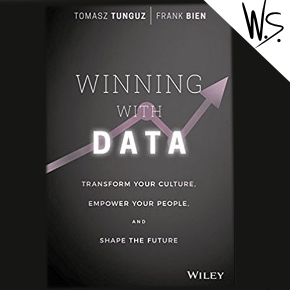以数据取胜:总结与回顾

关键词: 分析、分析、业务、数据、指标、信息、基础设施、投资者、运营、启动
请注意: 本文末尾有指向其他评论、摘要和资源的链接。
书评
在当今世界,数据正在改变每个行业。数据就是未来,懂得如何使用数据并将其付诸实践的公司比不懂数据的公司拥有巨大优势。为了在这个快速变化的环境中取得成功,公司中的每个人都应该能够立即获得做出最佳决策所需的信息。 以数据取胜 提供有关公司如何通过数据战略分析继续发展和发展的建议。
手机的出现使每个人对数据的需求和渴望成倍增加。人们期待数据。他们习惯于立即得到问题的答案。在这个数据丰富的环境中,避免常见的偏见和认知错误非常重要。在公司内部,数据团队可以成为减少偏见和促进数据素养的重要力量。团队应该教同事如何很好地使用数据;他们还应该帮助人们学会更清楚地交流数据。
指标可以对流程产生深远影响,并反映公司的竞争优势,但这并不是全部。公司不只是指标。公司还需要明确的价值观。它需要合适的人才:具有知识诚实的人、具有好奇心的人、会使用指标来回答问题的人。
的合著者 以数据取胜 两位作者都有数据密集型行业的背景。Tomasz Tunguz 是 Redpoint Ventures 的风险投资家,他的博客致力于为初创企业提供数据驱动的建议。Frank Bien 是商业智能平台 Looker 的首席执行官,他直言不讳地相信团队合作和积极的企业文化。那些有兴趣了解作者的职业生涯以及他们如何达成此次合作的人,建议阅读介绍。
Tunguz 和 Bien 举了大量来自他们自己以及其他知名公司经验的例子:Venmo 利用数据改进他们的产品;Warby Parker 颠覆了数十亿美元的市场;ThredUp 每天能够处理数千件物品。
以数据取胜 提供建议,帮助公司在一个美丽的新世界中航行。作者对创建数据驱动公司的建议逐步分解,包括:创建通用词典;振兴团队文化;保持会议正常进行;并进行高质量的演示。这份非技术性概述充分解释了数据的战略使用如何为任何公司带来竞争优势。
概括
第1章
广告业务过去偏爱电视节目中描述的那种创造性方法 狂人.如今,数学比创造力更能推动战略。代替 狂人,广告专业人士是数学人:信息技术提供了开发活动的工具;算法指导决策;几乎所有的工作都是在计算机上完成的。自那以后发生了相当大的变化 狂人 天。
数据已经改变了广泛的不同领域,而不仅仅是广告。数据是未来,公司必须了解如何使用它并随之发展。
在拥有可操作数据的公司中,数据驱动着每个员工的行为。例如,优步没有库存;整个业务都是基于数据的。该公司比老式出租车公司更有效地调度司机,并通过可轻松识别问题司机的反馈系统保持高满意度。数据 = 可操作。
即时数据已变得至关重要,对即时信息的需求也在增长。我们希望我们的问题能立即得到答复(!)。由于人们过去需要很长时间才能在公司内获取信息,因此数据历来被用作衡量过去绩效的工具。然而,拥有良好数据基础设施的公司可以根据当前指标生成信息并做出决策。这些公司可以确保数据能够立即到达需要的地方,并呈现在需要它的人面前。低效的供应链(接触数据的人员、流程和程序)导致数据速度缓慢,因为寻找数据的人比提供数据的人还多。这在过去是一个问题,但今天,我们的数据非常丰富,总有更多的数据可供收获。
然而,数据量使得对其进行排序比以前更加困难和耗时。小公司可能没有数据分析人员,创建和运行查询和报告可能会变得不堪重负。如果无法获得足够的数据,公司就会习惯于根据意见做出决策。这绝不是经营业务的最佳方式,这可能表明公司需要建立新的数据供应链。
一些企业有整个团队致力于确保数据的测量、描述和使用方式的一致性。他们辅导公司中的其他人,并授权他们创造性地使用数据。数据团队通过帮助每个人更好地了解如何使用数据而不是意见来推动公司发展,从而实现数据访问的民主化。
第2章
数据存在一些问题,这是我们这个时代的特征。
对词源好奇的人将有兴趣了解 Fleischmanns,捷克面包师,他们移民到美国并因今天仍在超市出售的烘焙酵母而闻名。 Fleischmann 一家每天都做面包,一天结束时他们总是会剩下一些,然后送给穷人。等待这个免费面包的人的队伍被称为 面包线.今天,数据贫乏的人有面包线。人们等待他们需要的信息就像穷人等待面包一样。一些数据请求被优先考虑;其他请求等待。数据面包线会导致多个问题:
- 人们必须等待数据。这会减慢决策过程,进而拖慢公司的发展速度。
- 人们会变得不耐烦,有时会在不等待数据的情况下做出决定。不知情的猜测很少会产生好的结果。
- 关注面包线会消耗数据管理团队的精力,阻碍他们的潜力,并浪费他们的才能。
数据模糊也是一个问题。当数据杂乱无章时,响应时间和准确性会减慢。最终,公司可能会对其数据失去信心。
数据碎片化是另一个问题。当人们无法获得所需的数据时,他们会想方设法获取数据并创建自己的数据库。流氓分析师和影子数据库通常会忽略正常的验证和更新流程,将信息置于孤岛之中。
最后,数据争吵会给公司带来重大问题。数据分割可能会造成不一致。如果信息不一致,人们就会开始不信任彼此的观点。他们意见不一,争吵不休,打架斗殴。公司里的人都需要达成共识。他们必须使用相同的指标和相同的词汇。
第3章
商业智能系统传统上分为三层:数据库存储数据;数据仓库从数据库中收集数据并进行聚合;和可视化层为最终用户格式化和呈现报告。这是一种陈旧的系统,因为每次提出不同的问题时,都必须为新报告编写新查询。
早在谷歌还是一家小型初创公司时,它就拥有大量数据,但无法负担 Oracle 的数据库费用。为了解决这个问题,他们购买了自己的服务器,并将数据分发给它们。这一策略奏效了,我相信您已经知道,谷歌如今已成为数据管理的典范。该公司生成了海量数据,谷歌员工将这些数据用于各种研究和分析。
Facebook 也非常重视数据分析,该公司开发了多种不同的技术,为员工提供数据访问。HiPal 界面让分析师可以更轻松地搜索数据。不熟悉 SQL(结构化查询语言 (SQL))的用户也可以使用这些公司技术进行与使用 SQL 相同的分析。其他公司(如 LinkedIn)也使用类似的数据基础设施。
Looker 是一种新型的数据接口。它创建了供整个组织使用的所有内容的单一版本,从而显着提高了数据完整性。
极端数据收集是新常态;所有大公司都有这些高性能数据库。它们非常快,存储便宜,并且有足够的空间和能力。鉴于这些进步,整个分析方法需要更新。可以积累大量信息,而精明的工人习惯于访问数据。他们需要复杂的工具来满足复杂的信息需求。使用工具越容易,使用它们的人就越多。
如今,有大量数据需要探索,人们可以自由探索。这是现代世界的数据结构。
关于数据技术历史的快速课程:该数据库是 1970 年由一位名叫 Edgar Cook 的 IBM 员工发明的。 Oracle Systems 成为数据库的主要开发商,并在他们的数据库中存储数据赚了很多钱。在 1990 年代,其他公司推出了使数据库更易于使用并最大限度降低数据库费用的软件。
第 4 章
通常,公司使用数据来查看过去发生的事情。新方法是操作数据并使用它来理解发生的事件。
过去,衣服和布料非常昂贵,甚至连贵族都会购买二手衣服。人们称斯特拉扎罗利 (Strazzaroli) 为经营高端二手衣服的人。但随着工业革命的加速,衣服变得越来越便宜,斯特拉扎罗利 (Strazzaroli) 失去了谋生手段。快进到一家现代寄售公司 The RealReal。他们使用实时报告来查看仓库里有什么以及价值链中所有事物的移动情况。公司中的每个人都可以访问相同的信息;每个人都可以实时对数据做出反应。设计、营销、财务、运营——每个人都可以使用即时信息来为公司谋利。
ThredUp 是另一家二手服装经销商。除了跟踪和处理商品外,ThredUp 还使用数据来预测在任何给定时间需要什么样的衣服。管理他们的数据帮助他们在启动后快速扩展。
公司在琐事上花费了太多时间。会议占用了每个人的时间。这会导致生产力下降。然而,正确的数据可以减少会议时间,因为它可以帮助人们专注于正确的问题。
HubSpot 是营销自动化软件的提供商,它跟踪五个指标来评估其销售人员的绩效。销售人员可以访问他们自己的仪表板,查看他们如何朝着目标前进。前面讨论过的 Looker 还创建了一个工具来跟踪销售业绩。销售人员可以看到他们离完成配额还有多远,并监控他们正在准备的东西。客户服务解决方案提供商 Zendesk 使用 NPS 客户调查来生成数据,这帮助他们保持了可观的增长。
数据是任何成功的现代企业的重要组成部分。它在销售库存、响应客户请求、在适当的时间增加销售人员以及提高反应速度方面发挥着重要作用。
本章包含来自作者的丰富建议:
- 在整个公司内采用相同的指标非常重要。考虑使用类似于数据字典的东西进行形式化和标准化。你需要有一个通用的词汇表。
- 要绝对诚实——或者至少要以这个理想为目标。人们不应该太敏感。放下你的自尊,接受批评。
如果没有数据支持,决策可能会变得非常武断。我们掌握的信息越多,做出的决策就越好。
第五章
好奇心是人类的基本情感,根据作者的说法,好奇心是将公司文化转变为数据驱动型文化的最佳方式。员工应该好奇。他们应该有能力查找他们感兴趣的信息,并且应该能够测试他们的假设。
当一家公司被数据驱动时,可以预期会有一些文化转变:
- 该公司开始使用数据来做出决策。
- 公司从每个人那里获得最好的想法,而不仅仅是高管。
- 公司鼓励实验和惊喜。
试验很重要。为了展示试验的价值,作者讨论了 Intuit 的工资管理产品 Paycycle。产品经理考虑加入一项功能,让雇主能够立即开具支票,但研究表明客户不会对这样的功能感兴趣。他们还是决定测试这项功能,结果出人意料地受欢迎。正确的文化始于好奇的员工;始于提出问题的人。
找到有好奇心的人很重要,而这要从招聘过程开始。但招聘面试通常不会提供太多信息。面试可能相当随意。相反,作者建议应该有一个系统的流程,包括确定候选人的理想素质、设计针对这些素质的面试问题,并根据候选人的理想属性对其进行评分。得分最高的候选人获胜。
招聘指标有助于评估招聘实践 — 例如,通过电话面试的合格候选人数量、从第一次联系候选人到签署录用通知的时间等。为了监控满意度,您可以在面试后对候选人进行调查,了解他们对这次体验的看法。另一个重要指标是录用通知接受率(接受录用通知的人数百分比)。通过将招聘人数除以招聘目标来计算您的招聘目标。
归根结底,您希望员工能够适应公司文化。但您如何衡量文化?使用调查和其他工具在管理层和员工之间建立关于公司的对话。人们的目标是什么?他们喜欢公司的哪些方面?他们可以给出什么反馈?这个过程一直持续到公司价值观具体化并可以记录下来。
明确这些方面可以让面试官更容易判断应聘者的价值观是否合适。例如,如果您的公司重视高质量的客户服务,您可以要求员工举一个他们帮助客户的例子。
谷歌在指标上比其他公司更进一步。他们绝对衡量招聘过程的所有方面,并为 HR 人员提供大量反馈。面试官通常会收到信息以提高他们的表现。
第六章
一旦你拥有了好奇的员工,他们就会开始问问题,这开启了数据驱动型公司的典型进程:
- 第一步:需要信息的人询问帮助创建和构建数据系统的工程师之一。随着公司的发展,这成为工程师的负担。
- 第二步:团队从其他地方借用解决方案。人们使用来自其他部门或其他公司的软件或其他工具。针对其他人的数据量身定制的解决方案可能不太合适。
- 第三步:团队获取原始数据并编写自己的查询。
Twilio 有两种数据搜索器。一方面,数据团队对数据基础设施及其使用方法了如指掌。他们喜欢可以多次运行并交付给适当受众的报告。另一方面,公司的其他人想要一个简单的界面,让他们能够浏览数据。满足这两个截然不同的支持者是数据基础设施的一项关键任务。
另一个问题是 IT 采购权的分散。团队领导和部门越来越多地购买软件,从而将数据团队排除在外。 (这种对技术部门缺乏问责制被称为影子 IT。)供应商乐于为他们的管理客户提供服务并提供定制的解决方案,但这会导致数据碎片化,不同的部门和单位对真相有不同的看法。
数据团队需要转变数据架构,赋予用户更多权力。最终用户应决定使用哪些报告工具。数据团队的角色是支持基础设施,以便用户可以分析数据。云数据库应与本地公司数据库配合使用。
数据结构(即公司内部的信息矩阵)必须可供所有人访问,而标准化的一种方法是通过数据建模。公司中的每个人都应该使用相同的数字并使用相同的语言。一致性非常重要。科学家和工程师可能了解公司的数据架构,但其他人可能不了解。数据结构使所有人都能访问信息。
第7章
第二次世界大战期间,一群数学家和统计学家在纽约举行秘密会议,分析军事数据并向华盛顿提出建议(这些建议经常被采纳)。团队中的一位成员亚伯拉罕·沃尔德 (Abraham Wald) 受空军委托设计飞机装甲。返回的飞机数据显示,大多数弹孔位于尾炮手和机翼周围,因此人们认为这些区域应该安装装甲。(装甲很重,所以他们不能直接将装甲安装在整架飞机上。他们必须有所选择。)但亚伯拉罕·沃尔德指出,机翼中弹的飞机才是幸存下来的飞机。作者讲述这个故事是为了说明避免数据偏差的重要性。
有许多潜在的陷阱、多种类型的数据偏差会阻止您理解数据:
- 幸存者偏差——任何时候从分析中删去数据,都有可能产生扭曲的结果。相关性不是因果关系;仅仅因为两件事似乎联系在一起,并不意味着一件事导致了另一件事。
- 锚定偏差——当有人向你提出一个值并影响你自己的估计时,就会发生这种情况。例如,如果我问甘地去世时是否超过 114 岁,你的答案可能与我问他是否超过 35 岁时不同。
- 可得性偏差——如果你亲眼看到某件事发生,或者从你认识的人那里听说这件事是如何发生的,你会觉得这件事似乎是一种更为常见的事件。
您可能会产生有效性的错觉,并相信收集更多数据将有助于预测未来,但有很多方法可能无法正确解释数据。当心。
Facebook 新员工参加为期两周的数据训练营,以提高数据素养。这为每个人讨论问题和机会提供了共同的背景。他们了解可用的工具和数据集。他们还有机会参与项目以扩展他们的知识。数据团队可以做很多事情来与员工会面并提高整个公司的数据素养。以这种方式处理公司文化是他们工作的重要组成部分。
第八章
描述性分析询问发生了什么;诊断分析询问原因。 (仪表板,在本书中受到诽谤,是描述性分析的接口。)
描述性分析和诊断性分析着眼于过去,而预测性分析和规范性分析则着眼于未来。预测性分析使用历史数据来预测未来结果。分析师可以提出假设性的“如果”问题来决定采取哪条路径。规范性分析根据数据推荐行动方案。这需要大量数据和复杂的分析。
数据复杂度之旅是市场研究机构 Gartner 开发的一个模型。数据复杂度描绘了团队从描述性分析到诊断性分析、从预测性分析到规范性分析的演变过程。但 Gartner 忽略了诊断性分析和预测性分析之间的一个方面:探索性分析。这有助于我们找到假设;这会问“为什么?”确认性分析用于确定假设是否正确。
数据只有在你能够采取行动时才有用。毫无理由地收集数据没有任何实际意义。另一方面,你并不总是知道哪些指标是可操作的,直到你完成分析之后。保持平衡是件好事。
某些指标是经过实践检验的。客户生命周期价值 (LTV) 是对一段时间内从客户身上获得的总毛利的估计。客户获取成本 (CAC) 是针对一位客户的所有销售和营销费用的平均总和。LTV/CAC 比率表明公司获取收入的效率。但有时可以根据情况量身定制新指标,而创建新指标可以发现新的机会。移动媒体网站 Upworthy 跟踪各种指标以评估哪些因素使他们的内容更受欢迎,但他们需要更多信息,因此他们发明了一种全新的指标来衡量实际用户注意力(即不考虑网页打开但读者去喂猫的那些时刻)。
设计一个实验。确定可行性。数据应该与可以做出的实际决策相关。确定预期结果。提前确定实验参数。设计实验。提出假设。确定几个不同的数据点。计算 p 值。p 值是假设不正确的概率。提供了此计算的说明。计划运行实验。确定需要多长时间。您需要多少个样本。谁将进行这项工作,以及如何构建工作。不要忘记包括一个对照组来检查结果。运行实验。分析结果。将它们与对照组进行比较。
第九章
纽约市向公众提供了大量数据。一位名叫 Ben Wellington 的人开始分析数据,并在他的博客上报告了这些数据,包括绘制城市自行车事故图等内容。他变得非常受欢迎,他将自己的成功归功于他讲故事的能力。
威灵顿的经验教训包括让数据具有可关联性的重要性。将数据变成故事。(我一直告诉我的团队!)有些人认为数据有点无聊,单凭数据不足以激励他们。通过将其变成故事,您可以赋予它情感吸引力。在吸引投资者时,能够讲述自己的故事尤为重要。向投资者推销初创企业的企业家需要表明他们已经发现了新的机会——表现出紧迫感。
传达数据的标准方法是通过演示。首先要定义演示的目标。您要解释什么?您是要说服某人吗?您是要推销某样东西吗?评估目标受众。投资者对风险特别感兴趣,因此讨论这些要点表明您了解投资者的观点。(风险有很多种,请参阅侧栏。)发展故事情节很重要。根据您对投资者的希望和担忧的了解,创建一个解决这些问题的故事情节。力求将其保持在 10 张或更少的幻灯片中。
演示可以从公司的目标或使命开始。描述问题。您的产品将解决哪些问题?然后提供解决问题的方法。解释为什么现在这是一个好主意,以及为什么以前没有人这样做。演示您的产品会很好,但图片也很好。演示中应包含的其他重要信息:市场规模、您的团队、商业模式、竞争对手和财务状况。
传达您对机会的愿景,并用数据强化愿景。提供解决方案。解释公司的方法。展示市场如何反应。参与度和获取指标在这里会很有帮助。提供对市场规模的良好估计很重要。风险投资家绝对想知道这一点。我们在这里谈论的潜在市场有多大?对财务状况的讨论至少应包括收入、毛利率和现金流。
当你做演讲时,人们会有疑问。你拥有的数据越多,你就越能准备好回答这些问题。
一些不同类型的风险:
市场时机风险——对于这家企业来说,现在是否是合适的时机?
商业模式风险——您是否拥有适合您的产品的模式?
市场采用风险——人们会使用你的新产品吗?
市场规模风险——您的解决方案是否足以让风险投资家满意?
执行风险——您的团队是否具备完成这项工作所需的适当技能?
技术风险——如果开发了新技术,是否能够按时完成?
资本化风险——是否有足够的资本来维持下去?
平台风险——是否存在你无法控制的外部合作伙伴?
风险管理风险——公司是否愿意接受反馈?
财务风险——公司能否继续支付账单?
法律风险——是否有诉讼或其他法律问题即将发生?
第 10 章:将所有内容放在一起
把它放在一起
一家公司可能会有很多摩擦。数据可以帮助减少这种摩擦。
人们需要理解和期待数据。人们需要诚实守信;决策过程与自我无关。让最好的想法获胜,不要让政治影响选择。公司需要明确的价值观。它需要合适的人才,需要好奇的人。
为这个美丽的新世界武装企业的最佳方式是使用数据,而对数据的渴望越来越全球化。它确实正在改变每个行业。未来,操作数据将为企业提供成功所需的竞争优势。人们将立即获得做出最佳决策所需的信息。
指标可以对过程产生深远的影响。它们可以改善企业的运营方式,从而赋予其竞争优势。凭借统一的数据结构和优秀的团队,公司正在改变他们的行业。
